On the Alcoholism Front
In the early days of AA, alcoholics and their families embraced the foundling Fellowship and celebrated its simple and effective method of "one alcoholic talking to another." But early AAs also recognized the importance of being friendly with our friends. As stated in the Foreword to the Second Edition of Alcoholics Anonymous, "another reason for the wide acceptance of AA was the ministration of friends--friends in medicine, religion, and the press, together with innumerable others who became our able and persistent advocates. Without such support, AA could have made only the slowest progress." Some of the recommendations of AA's early medical and religious friends are found in The Doctor's Opinion and the Appendices in the Big Book.
Today, the support and recommendation of such friends is just as important to the growth and vitality of our Fellowship as it was when AA was in it's infancy. Currently, across the United States and Canada, this work often falls under the banner of Cooperation with the Professional Community, or CPC.
According to the CPC Workbook (available from your local CPC committee or central office), "Cooperating with nonalcoholic professionals is an effective way to carry the message to the sick alcoholic. Such people often meet the alcoholic in places where AA is not present. Through professionals, alcoholics may be reached who might otherwise never find the program, or they may be reached sooner with the help of informed non AAs."
Many AAs ask, "Who is considered a professional?" Although doctors, judges, and psychiatrists usually top the list of professionals who come in contact with alcoholics, a broader grouping is more accurate: that is, anyone who deals with problem drinkers in the course of their work. These include: armed forces officer; athletic coach; attorney; corrections officer; court official; educator; employer or employee assistance professionals; clergyperson; juvenile service professional; parole officer; public health official; senior services professional; social worker; and union official.
Bob M., chairperson of the trustees' committee for CPC/Treatment Facilities, encourages AAs to think of all the professionals they have encountered during their drinking, not just legal or medical professionals. Many of these professionals often encounter the suffering alcoholic, but in spite of public awareness, a great many simply don't know what to do with a drunk.
Bob also pointed out that many AAs of his acquaintance didn't often talk to clergy, although Appendix V in the Big Book glowingly reported that "Clergymen of practically every denomination have given AA their blessing." While serving as a District Committee Member, he was contacted by a member of the clergy who reported that his fellow colleagues, in their monthly meeting of religious professionals, believed that AAs were saying that God was doorknobs and trees. "The clergyman asked if I would come to speak at their next meeting and clarify what AA is and is not. I arrived, and did just that. I also shared my story with them, and the questions kept on coming. By the end, they had a much better idea of how helpful AA was and how they could use AA to assist their congregation."
Whenever AAs reveal their membership to their doctors or drop a quiet word in the ear of a pastor, priest, rabbi, or imam that an AA member is available to the congregation, CPC work begins. When groups welcome, or CPC committee members escort professionals and future professionals to open meetings, the groups are participating in CPC work. In addition, when committees in the area or on the local level go about seeking ways to contact professional people and set up programs to increase knowledge and understanding of Alcoholics Anonymous--CPC work is being accomplished.
Cooperation with nonalcoholics was the lifeblood of AA in its early years. Alan S., of Rio Rancho, New Mexico, observed, "Our Twelfth Step tells me to try 'to carry this message to other alcoholics.' Further in the book, I am told where to find these alcoholics--by 'asking a few doctors, ministers, priests, or hospitals.' Over the years, AA has also reached out to correctional facilities. This is not a new idea--if it were not for this type of action, AA might not be here today. Ebby, who carried the message to Bill W., was rescued from the courts by the Oxford Group. And Bill, with the permission of Dr. Silkworth, began working with alcoholics in the hospital he had been a patient at. On the day before Mother's Day in May 1935, Bill called a minister from the Mayflower Hotel in Akron, Ohio, and was finally put in contact with Dr. Bob. These actions created a precedent of seeking out those who needed help through professionals and continues today through even wider cooperation with the professional community."
It is important to remember that cooperation with professionals--like everything else in AA--is based on personal contact. And this way of life, for many AAs, has become most welcome.
In the March 1958 issue of the Grapevine, Bill W. wrote a piece that has since become well-known in service circles: "Let's Be Friendly With Our Friends: Friends on the Alcoholism Front." Within the article, he asks about the fate of those who "haven't hit prisons, asylums, or skid rows." He questions, "Why haven't these millions come to us? Or why haven't they tried to get well by some other method?" Any AA can give you a quick and very accurate answer: 'They aren't ready--they don't know how sick they really are. If they did, they would flock to treatment, just as though they had diabetes or cancer.' The problem, therefore, is how to expose them to the facts that will convince them they are gravely ill. More than anything, the answer seems to be in education--education in schoolrooms, in medical colleges, among clergymen and employers, in families, and in the public at large."
Today, Bill's suggestion is being earnestly followed: The AA General Service Board has a Committee on Cooperation with the Professional Community; so has the General Service Conference. The AA General Service Office in New York maintains a desk called Cooperation with the Professional Community (CPC) that answers queries from doctors, nurses, judges, lawyers, clergy, health workers, educators, and many other professionals who come in contact with active alcoholics. But, as always, at the heart of our endeavours are one-on-one encounters coupled with a desire to be helpful. Bill wrote, "So let us work alongside all these projects of promise to hasten the recovery of those millions who have not yet found their way out. These varied labors do not need our special endorsement; they need only a helping hand when, as individuals, we can possible give it."





